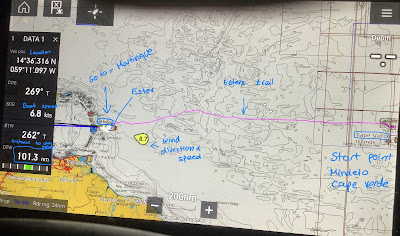First night shift on this cruise. It has been 15 hours since we left Pilos, Greece, and we have another 35 hours to reach our destination in Italy. We do 4-hour shifts, one asleep, the other must be awake, and look around. I set a timer to remind me to scan the horizon every 10 minutes. It's easy to sink into an occupation and forget that I'm actually on duty… Our navigation device works, chart plotter in professional jargon. On it is displayed the AIS, one of the important aids, receives location transmissions of all the large ships around you (mandatory on large ships), as well as smaller vessels that have installed a transmitter. In preparation for the great journey, as part of the improvements we made to Esther, we replaced the system that only received transmissions with a system that also broadcasts. Honestly, we have no idea if we are really broadcasting, need a neighboring boat to approve. This is a huge upgrade in terms of sailing safety, especially at night. On the display you can see the direction of the boat, its name, the type of vessel (voyage / passengers / sailboat, etc.), identification of the connection, speed, distance from us, what time it will be at the point closest to us, port of departure and destination. Additionally it is possible to activate an alert system that beeps hysterically if it has detected a vessel in the range you define. The wonders of technology! Makes redundent all the theoretical knowledge of identifying boats and their direction of navigation by dim lights when part of the job is a wild guess as to whether the vessel you saw is approaching or receding. Allows the captain to sleep soundly and trust his wife, or rather the technology, to do the job (his wife he does not trust so much…). Apart from this system, we have also installed a radar that allows us to detect boats that do not broadcast or other objects (land, significant rocks, etc.). We installed this system also prior to the launch. In short, we have invested in Esther for the sake of safety and at the expense of inheritance for children….
So what do I do 4 hours alone in the middle of the sea?
Half moon, glowing stripe on the sea, humming engine (unfortunately we are not on a sail, wind is too weak and coming from the bow), automatic steering wheel keeps direction. Lets you do a lot and at ease.
Thorough cleaning of the kitchen after a pampering fish meal. Yes!
First day of sailing, Udi lowers a fishing rod, for the first time on this journey. A new rod he bought in Portoheli, near Kilada, with a Rapala (a plastic fish used as bait), which the seller promised was a fishing champion in the Mediterranean. He said and was right, after a few hours we caught an albacore tuna, one that we often caught on cruises far from the shore, weighing 5 kg. Comfortable size for a couple…
So this is what we ate for dinner:
So what do I do 4 hours alone in the middle of the sea?
Half moon, glowing stripe on the sea, humming engine (unfortunately we are not on a sail, wind is too weak and coming from the bow), automatic steering wheel keeps direction. Lets you do a lot and at ease.
Thorough cleaning of the kitchen after a pampering fish meal. Yes!
First day of sailing, Udi lowers a fishing rod, for the first time on this journey. A new rod he bought in Portoheli, near Kilada, with a Rapala (a plastic fish used as bait), which the seller promised was a fishing champion in the Mediterranean. He said and was right, after a few hours we caught an albacore tuna, one that we often caught on cruises far from the shore, weighing 5 kg. Comfortable size for a couple…
So this is what we ate for dinner:
 |
| Perfect tuna for a double meal |
 |
| A type of Moroccan fish and rice |
Apart from the above, I read, write, ponder… constantly busy with pleasant occupations.
About 60 hours of sailing to Reggio di Calabria, Italy, just before the Straits of Messina, pass quite comfortably.





No comments:
Post a Comment